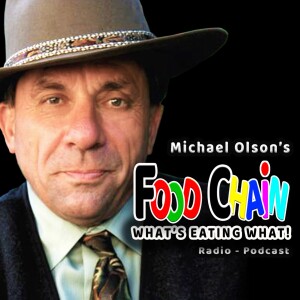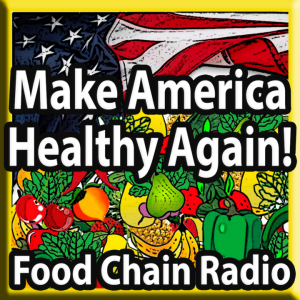
1.4K
Downloads
75
Episodes
It’s a fact! 100% of men, women and children eat food, and 97.5% of must buy their food from others who bring it from an average of 2,000 miles away. And so the hungry ask: ”What’s in this tomato? Who planted that broccoli? Is it safe to eat genetically engineered corn? Why are they irradiating meat? Are we running short of water? Why is China growing our apples? What will happen to us if we can no longer farm? How safe is our food chain?” The Food Chain is an audience-interactive syndicated newstalk radio program and podcast broadcasting weekly on radio stations and streaming on demand on the internet. The Food Chain, which has been named the Ag/News Show of the Year by California’s legislature, is hosted by Michael Olson, author of the Ben Franklin Book of the Year award-winning MetroFarm, a 576-page guide to metropolitan agriculture. The Food Chain is available live via GCN Starguide GE 8 and delayed via MP3/FTP. For clearance and/or technical information, please call Michael Olson at 831-566-4209 or email michaelo@metrofarm.com
Episodes

Thursday Jan 23, 2025
ANATOMY OF THE FOOD RECALL
Thursday Jan 23, 2025
Thursday Jan 23, 2025
Food now travels a long way from where it was grown to where it is eaten. Sometimes bad things happen to good food along the way. This leads us to ask:
What happens when bad food gets eaten by good people?
The Food Chain Radio Show - Podcast with Michael Olson hosts Wiggs Civitillo, Founder & CEO | Starfish-Network, for a conversation about the tracking food as it travels the food miles from farm to fork.
Topics include why the U.S. has three to five hundred food recalls every year; how all food that travels food miles will soon be tracked from farm to fork; and the technology that will– hopefully – make it possible to track food and keep people safe.

Wednesday Jan 15, 2025
Ep. 1380 Biodynamic Lotions, Potions & Notions
Wednesday Jan 15, 2025
Wednesday Jan 15, 2025
Hippocrates is said to have said, “Let food be thy medicine, and let medicine be thy food.” What Hippocrates said so long ago leads us to ask:
Which food makes the best medicine?
The Food Chain Radio Show - Podcast with Michael Olson hosts Carin Fortin & Delmar McComb, Owners and Farmers, Blossom’s Biodynamic Farm, for a conversation about the biodynamic growing of food that that is medicine.
Topics include why Fortin and Delmar employ biodynamic technologies to grow a hundred varieties of medicinal herbs; how their medicinal herbs are converted into lotions and potions; and how notions are used to sell their medicinal preparations directly to customers at farmers markets.
Radio Affiliation: The one-hour “Biodynamic Lotions, Potions & Notions” (#1380) is available as a market exclusive at www.foodchainradio.com.

Friday Jan 10, 2025
Ep. 1379 Farming Flowers for the Table
Friday Jan 10, 2025
Friday Jan 10, 2025
Kaysea Clark, Owner & Farmer, Flowers by the Sea
They say “The eyes are first to feast!” If such is indeed the case, we wonder,
Which flower is best to feast on?
The Food Chain Radio Show - Podcast with Michael Olson hosts Kaysea Clark, Owner & Farmer, Flowers by the Sea, for a conversation about growing and selling flowers to enjoy with food.
Topics include Clark’s transition from gardener to farmer; why the technology of her biologically-intensive farming are important to the character of her flowers; and how Clark sells flowers at farmers’ markets.
Show Recording: “Food with Flowers Farmer” (#1378)
Radio: www.santacruzvoice.com
Host: www.metrofarm.com
Sponsor: TimeShare Media

Wednesday Dec 18, 2024
Ep. 1357 Yellowstone's King Corvid
Wednesday Dec 18, 2024
Wednesday Dec 18, 2024
Fred Provenza, Professor Emeritus of Behavioral Ecology in the Department of Wildland Resources at Utah State University. Author, Nourtishment: What Animals Can Teach Us About Rediscovering Our Nutritional Wisdom
Yellowstone Park in winter is a cruel place for the wildlife that can no longer endure its cold, snow and hunger. And yet what is cruel for some can be a blessing for the corvids of Yellowstone’s winter And so we ask:
Can anyone love the black birds of Yellowstone’s white winter?
Topics include speculation as to why people have always disagreed about the best way to eat; a discussion of the nutritional and environmental elements of the different ways of eating; and a common sense approach to putting the argument to rest.

Sunday Dec 15, 2024
Ep. 1378 Kennedy's MAHA Moment
Sunday Dec 15, 2024
Sunday Dec 15, 2024
David Blume, Farmer at Whisky Hill Farm in Freedom, California, Author of Alcohol Can Be A Gas, proprietor of Blume Distillation, & Candidate to be Robert Kennedy Jr’s Food & Energy Coordinator
They are moving on Washington, DC with the battle cry, “Make America healthy again!” Their battle cry leads us to ask:
How can America be made healthy again?
The Food Chain Radio Show - Podcast with Michael Olson hosts US HHS Food and Energy coordinator candidate David Blume for a conversation about how he would help Robert Kennedy Jr make America healthy again.
Topics include why Kennedy believes America’s food chain must undergo a revolutionary change; ways in which that change might be made; and how revolutionary change can be made given all the money lined up to prevent it from being changed.

Wednesday Dec 11, 2024
Ep. 1378 Food Chain Radio: 2024's Food Revolution
Wednesday Dec 11, 2024
Wednesday Dec 11, 2024
They are moving on Washington, DC with the battle cry, “Make America healthy again!” Their battle cry leads us to ask:
How can America be made healthy again?
The Food Chain Radio Show - Podcast with Michael Olson hosts US HHS Food and Energy coordinator candidate David Blume for a conversation about how he would help Robert Kennedy Jr make America healthy again.
Topics include why Kennedy believes America’s food chain must undergo a revolutionary change; ways in which that change might be made; and how revolutionary change can be made given all the money lined up to prevent it being changed.

Thursday Dec 05, 2024
Ep. 1377 Real Food from Real Farmers - Guaranteed!
Thursday Dec 05, 2024
Thursday Dec 05, 2024
Michael Olson with Catherine Barr, Executive Director, Monterey Bay Area Certified Farmers Markets
In the 1826 edition of The Physiology of Taste, Jean Brillat-Savarin wrote, “Tell me what you eat and I will tell you what you are.”
Then in the 1863 edition of Spiritualism and Materialism, German philosopher Ludwig Feurerbach wrote, “A man is what he eats.”
Today, in the 1377th edition of the Food Chain Radio Show, Michael Olson is jumping into the conversation by saying, “If we are what we eat, then we are what our food ate.”
Following that thought will take us deep into the soil, where everything is eating everything. It is the great smorgasbord of life that we do not see, and therefore just take for granted, like we do with all that food that fills the grocers’ shelves.
But if we really want to know what we are, we must come to grips with what our food eats. That is not an easy thing to do, because so much of what we eat now comes to the table wrapped in fancy packaging from thousands of miles away. What that food has eaten should be listed on the package label, but that means we must trust in the truthfulness of whoever wrote the labels, and they are in the business of selling food to people they will never meet.
There is one way to really know what food our food has eaten, and that is to look directly into the eyes of the farmer who grew that food, and ask him or her. Aside from the farm itself, there is one place where one can shop and be guaranteed that the food for sale is real food. And so we ask:
Where can one be guaranteed the food for sale is real food from a real farmer?

Saturday Nov 30, 2024
Ep. The Tyranny of Oligarch Food
Saturday Nov 30, 2024
Saturday Nov 30, 2024
Michael Olson with Tereza Corragio, Author, How to Dismantle an Empire
America’s big money oligarchs are buying up the world’s farmland and its fake-food companies. Guessing at what their intentions might be leads us to ask:
Can we escape the tyranny of oligarch food?
Topics include how communities lose their food and financial sovereignty to the empire of debt; how the empire of debt might be dismantled with community banking; and how to begin the dismantling.
